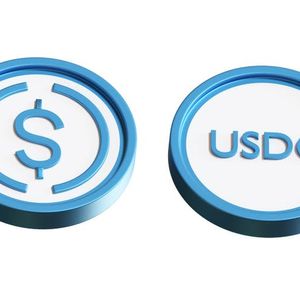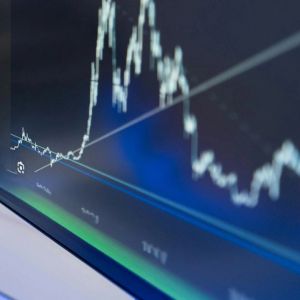Summary Circle's IPO is well-timed, benefiting from regulatory clarity and growing institutional trust in USDC's transparency versus competitors like USDT. CRCL's partnerships with Visa, Mastercard, BlackRock, and ICE position it to capture a share of the $212B cross-border payments market. Strong financials: Q1 revenue up 58.5% YoY, but high distribution costs—especially to Coinbase—pressure margins and highlight the need for better terms. Short-term bullish due to IPO momentum and regulation, but the long-term outlook is uncertain given interest rate sensitivity and reliance on interest income. As a long-term BTC and ETH investor, Circle's (CRCL) IPO caught my attention recently. I've known stablecoins like USDC and USDT for many years. As much as I'm excited to see Circle's stock rally over the past few days, I was more surprised by how profitable stablecoins can be and how Circle has evolved beyond just USDC. After reading its IPO prospectus, I realize that the company is not just a stable coin, and it may have the potential to transform into a strong global payment network. For those unfamiliar with USDC and digital currency, here's some quick background on Circle. Circle launched USDC in 2018 as a stablecoin to act as a medium for moving funds between different cryptocurrencies without needing to convert back to fiat currency (USD). All cryptocurrencies need trading pairs, similar to real currency. If you want to move from one cryptocurrency to another by converting to USD each time, it's costly and time-consuming. Stablecoins are pegged to USD at 1:1 ratio, so you can view them as digital USD. It's like chips in a casino. You give $100 to the cashier for $100 in chips, play in the casino, and redeem the chips when you're done. The casino guarantees the chips' value is 1:1 to real dollars. Also, due to the volatility of most coins, sometimes stablecoins act as a base for many decentralized finance applications, or what we call DeFi. Stablescoins are essential for staking (earning yields), lending and providing liquidity for different trading pairs. According to Circle's prospectus , USDC is the second-largest stablecoin with a 24% share of the stablecoin market as of December 31, 2024. The largest stablecoin is USDT, issued by Tether. According to CoinMarketCap, Circle has currently issued $61.55B in USDC while Tether has issued $155.5B in USDT, more than twice the volume, and takes around 60% of market shares. Trust And Transparency Though USDC is smaller in volume, it's the preferred stablecoin for many large institutions due to its transparency. The company states: "All Circle stablecoins minted and outstanding are backed by at least an equivalent amount of fiat currency-denominated reserve assets held in accounts." All stablecoin companies claim they're safe and backed by real fiat assets, but some have proven otherwise, like the famous death spiral of Terra Luna's stablecoin. Even with USDT, some analysts claim an unexpected EU ban or liquidity crisis could cause USDT to collapse. Trust and liquidity are crucial for stablecoins, just like traditional banking. If most clients lost trust in the bank and decided to withdraw deposits at the same time, the bank would collapse. Therefore, I believe Circle being the first public company with a transparent balance sheet is very beneficial, and it might motivate people to move from USDT to USDC in the long run. Remember, USDT has 60% of the market share. If 5% of USDT users move to USDC, it can boost Circle's market value by another $7- $8 billions. Perfect Timing The timing of this IPO couldn't be better. On June 17, the US Senate approved the Guiding and Establishing National Innovation for US Stablecoins (GENIUS) Act by a solid majority of 68 to 30 vote. The GENIUS Act requires "every payment stablecoin to hold reserves equal to the number of tokens in circulation, limited to short-dated US Treasuries or insured deposits, and bars issuers from paying yield." This is exactly what Circle says it's doing. This law signals the government's endorsement of digital currency, which is a big confidence boost for investors. Once the GENIUS Act categorizes stablecoins as payment tools, similar to credit cards or bank accounts, this officially moves USDC from crypto-only finance to traditional finance. The market opportunities are limitless. Since the law passed, shares of Circle have jumped significantly and many governments in Asia have been discussing whether the government shall launch official stable coins. It is a strong signal that stable coins like USDC are now officially becoming mainstream. Speaking of challenging traditional finance, Circle's payment network has worked with Visa and Mastercard, and this is where things get interesting. When people send money internationally through big banks, it takes days and costs $25-50 in fees. Globally, banks use a secure messaging system called SWIFT to communicate and to authenticate transactions. Circle could potentially challenge SWIFT. It can build a similar secured communication system between different financial institutions and lower the transaction cost and shorten the transfer time. SWIFT is built on old technology that was invented decades ago, and it was not built for speed. Circle can potentially challenge that. Investment banks like BlackRock and BNY Mellon have already partnered with Circle. According to its latest press release , Intercontinental Exchange Inc. ( ICE ) also signed an agreement with Circle recently to “explore using Circle's stablecoin USDC, as well as their tokenized money market offering US Yield Coin (USYC), to develop new products and solutions for customers”. According to Grand View Research , the global cross-border payments industry is around $212.55 billion in 2024, projected to grow at 7.1% CAGR through 2030. If Circle could capture 2-5% of the cross-border payments market as it described in the prospectus, that can translate into $4-11B in annual transaction volume potential by 2030. I believe Circle has significant first-mover advantages in this space. Building up a 1:1 USD pegged digital currency sounds easy, but setting up API integrations and cross-border onchain and offchain payment infrastructure takes considerable time and resources. The company's existing partnerships with major financial institutions, exchanges, and payment processors create switching costs and network effects that will be difficult for competitors to replicate quickly. Strong Financials Q1 revenue reached $578 million, a 58.5% increase YoY, with net income of $64.8 million vs. $48.6 million in the prior year, a 33.2% increase. Both topline and bottom-line show strong growth momentum. USDC transaction volume surged, with roughly $6 trillion processed in Q1 and over $25 trillion since launch. Taking a deeper dive into the P&L, we can see the company's main expenses are distribution and transaction costs, which account for almost 40% of total revenue. According to the prospectus, Circle shares revenue “generated from USDC reserves pro rata based on the amount of USDC distributed and held on each respective platform”. Among all platforms, Coinbase (Nasdaq: COIN) is the biggest winner. According to the prospectus, "For the years ended December 31, 2024, 2023, and 2022, we incurred $907.9 million, $691.3 million, and $248.1 million, respectively, of distribution costs in connection with our agreements with Coinbase." To put this in perspective, Circle's total 2024 revenue was only $1.66 billion, but they paid $907.9 million to Coinbase, more than half their total revenue. If Circle grows larger and gains stronger bargaining power to renegotiate its revenue share percentage with different platforms, especially Coinbase, the company's margins could be significantly higher. Potential Risks The two biggest risks for Circle are falling yields on short-term US bonds and rising competition. Regarding interest rate risk, Circle's revenue model is highly sensitive to Federal Reserve rate changes. Here's how different scenarios impact Circle's revenue assuming $43.9B USDC outstanding as of December 31, 2024: Fed Funds Rate Annual Revenue Impact Net Margin Est. Revenue Change 2.0% $878M 6.5% -35% 4.0% $1.76B 9.2% +30% 6.0% $2.63B 12.1% +95% *Based on 2024 revenue of $1.66B, this suggests 3.8% effective yield on reserves A 100 basis point rate change translates to roughly $439M annual revenue impact, which means the business model is highly interest rate sensitive. The company's 40% distribution cost ratio means net revenue sensitivity is even higher. It's hard to predict interest rate trajectory, but we are currently facing falling interest rate projections, which poses a potential headwind for Circle's topline in the near term. In terms of competition, Circle's business model may sound easy, but compliance can be very costly, web3 adoption and building digitally native environments takes time. Many big banks want to issue stablecoins, as do major companies. PayPal (PYPL) launched stablecoin PayPal USD (PYUSD) back in 2023, making it the first major financial institution to issue a USD-backed stablecoin. But two years later, it still makes up less than 1% of the market. The Stablecoin concept stems from the blockchain industry, so I believe a crypto native player with deeper roots in the blockchain ecosystem has a bigger advantage to traditional finance giants. Issuance is not the key to success, adoption is. Conclusion: Short-Term Bullish, Long-Term Uncertain Overall, Circle operates in a massive and fast-growing market. Over the next 3 to 6 months, I’m feeling pretty bullish for a few reasons. The first and foremost reason is the regulatory tailwinds and the momentum from the IPO. That said, the stock’s run-up feels a little too hot right now, so I’m holding off. I’d rather wait for a pullback before jumping in. Since Circle is a growth stock, it’s tough to evaluate it using a traditional DCF model. But here’s a quick back-of-the-envelope calculation: according to CoinGecko, the stablecoin market cap could reach $2 trillion by 2028. If Circle maintains its current 24% market share, that would put USDC’s volume at around $480 billion, roughly 8x where it is now. Based on that, net income could reach $128 billion, an 800% growth rate. That said, this is all three years out. Right now, if we take the IPO price of $31 as a fair starting point, the stock has already jumped 8x to $240 per share as of June 20 closing price. So in the short term, it feels a bit overheated. Of course, this calculator is simply based on USDC reserves. Circle may be able to generate money transfer fees like SWIFT or PayPal. Longer term, it's hard to tell because the company's revenue stream right now is simply relying on interest returns. If the company can’t negotiate more favorable profit sharing deals with its partners like Coinbase, or Circle cannot increase other revenue sources, a small yield swing can move the company's bottom line from highly profitable to negative. Traditional banks hedge interest rate sensitivity through loan spreads and different fee incomes, but Circle is not equipped to do so just yet. So while I’m optimistic in the near term, I need to see how they build a more resilient model (evolve beyond pure interest arbitrage) before getting too excited long term.



















